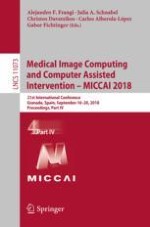2018 | OriginalPaper | Buchkapitel
Craniomaxillofacial Bony Structures Segmentation from MRI with Deep-Supervision Adversarial Learning
verfasst von : Miaoyun Zhao, Li Wang, Jiawei Chen, Dong Nie, Yulai Cong, Sahar Ahmad, Angela Ho, Peng Yuan, Steve H. Fung, Hannah H. Deng, James Xia, Dinggang Shen
Erschienen in: Medical Image Computing and Computer Assisted Intervention – MICCAI 2018
Aktivieren Sie unsere intelligente Suche, um passende Fachinhalte oder Patente zu finden.
Wählen Sie Textabschnitte aus um mit Künstlicher Intelligenz passenden Patente zu finden. powered by
Markieren Sie Textabschnitte, um KI-gestützt weitere passende Inhalte zu finden. powered by
